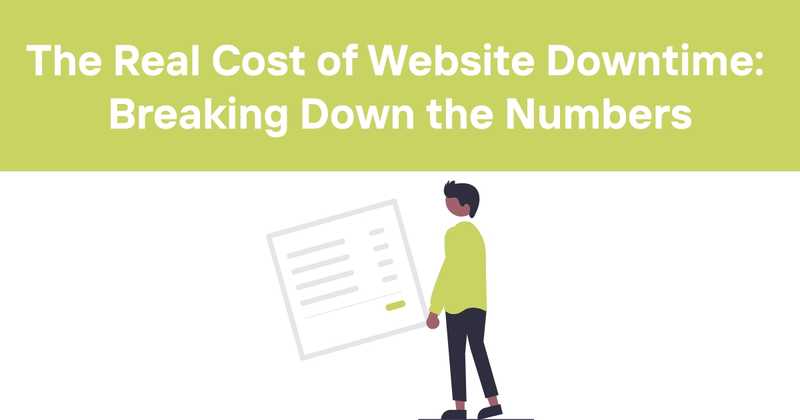The Real Cost of Website Downtime: Breaking Down the Numbers
You're coding away, lost in the flow, when suddenly your phone buzzes. It's an alert - your company's website is down. Your heart sinks as you realize every passing second is costing real money. But how much exactly?
As a developer who's been through more than a few outages, I can tell you the financial impact of downtime is no joke. Let's dive into the cold, hard numbers and see just how costly those dreaded outages can be.
Table of Contents
- The Average Cost of Downtime
- Factors That Influence Downtime Costs
- Calculating Your Downtime Costs
- Hidden Costs of Outages
- Downtime Costs by Industry
- Real-World Downtime Horror Stories
- Strategies to Minimize Downtime
- The ROI of Uptime Monitoring
The Average Cost of Downtime
Let's cut to the chase - downtime is expensive. Really expensive. Recent studies peg the average cost at around $5,600 per minute.
But wait, it gets worse.
That number has been creeping up over the years. More current estimates put it closer to $9,000 per minute on average.
Take a second to let that sink in. At $9k a minute, we're talking over half a million dollars per hour of downtime. Ouch.
Of course, these are just averages. The real cost for your specific business could be higher or lower depending on a variety of factors. Speaking of which...
Factors That Influence Downtime Costs
Not all downtime is created equal. The financial hit can vary wildly based on:
-
Company size: As you might expect, larger companies tend to lose more during outages. A mom-and-pop online store might only lose a few hundred bucks an hour, while an e-commerce giant could be hemorrhaging millions.
-
Industry: Some sectors are more vulnerable to downtime costs than others. We'll break this down in detail later, but spoiler alert - if you're in finance or e-commerce, downtime hurts. Bad.
-
Time of outage: An hour of downtime at 3 AM on a Tuesday probably won't sting as much as going offline during Cyber Monday.
-
Duration: Longer outages don't just add up linearly. The damage to your reputation (and customer patience) compounds over time.
-
Type of outage: A minor glitch that slows your site is one thing. A complete crash or security breach is a whole other level of pain.
Calculating Your Downtime Costs
Want to figure out how much downtime could cost your company? Here's a simple formula to get you started:
Let's break that down:
- Lost Revenue:
- Lost Productivity:
- Recovery Costs: This varies, but include things like:
- Overtime pay for IT staff
- Emergency vendor services
- Data recovery expenses
For a more precise estimate, you'd want to factor in things like reputational damage and potential compliance fines. But this formula gives you a solid starting point.
Hidden Costs of Outages
The immediate financial hit is just the tip of the iceberg. Outages can have ripple effects that aren't always easy to quantify:
-
Customer Churn: In today's impatient digital world, users have zero tolerance for downtime. One bad experience can send them straight to your competitors.
-
Brand Damage: Nothing erodes trust faster than unreliability. Frequent outages can tarnish your reputation for years.
-
SEO Impact: Extended or frequent downtime can hurt your search engine rankings. Google doesn't like sending users to sites that might be offline.
-
Employee Morale: Constant firefighting takes its toll. Burned-out employees are less productive and more likely to leave.
-
Opportunity Cost: While you're scrambling to get back online, you're not innovating or growing your business.
-
Legal Risks: Depending on your industry, downtime could put you in breach of service level agreements (SLAs) or regulatory requirements.
These hidden costs can often exceed the immediate financial losses. It's why smart companies invest heavily in preventing downtime rather than just reacting to it.
Downtime Costs by Industry
Now, let's get specific. Different industries feel the pain of downtime in very different ways:
| Industry | Average Cost per Hour |
|---|---|
| Banking & Finance | $6.48 million |
| Energy | $2.48 million |
| Telecommunications | $2 million |
| Manufacturing | $1.5 million |
| Retail | $1.1 million |
| Healthcare | $636,000 |
| Media | $90,000 |
A few observations:
- Banking & Finance: No surprise here. When money can't move, the losses stack up fast. Plus, the reputational damage in this trust-based industry is brutal.
- Energy: Critical infrastructure with real-world consequences. An outage here isn't just costly - it can be dangerous.
- Manufacturing: Modern factories rely heavily on digital systems. When they go down, entire production lines grind to a halt.
- Healthcare: While the hourly cost might seem lower, the potential human impact of healthcare system outages is incalculable.
- Media: Surprised this is lower? Many media companies have redundancies built in. Still, ad revenue losses add up quick.
Real-World Downtime Horror Stories
Sometimes, the best way to grasp the impact of downtime is through real examples. Here are a few doozies:
-
Amazon's Prime Day Crash (2018)
- Estimated Loss: $100 million
- What Happened: Amazon's servers couldn't handle the Prime Day traffic surge. The site was down for hours on one of their biggest sales days of the year.
-
Facebook's 14-Hour Outage (2019)
- Estimated Loss: $90 million
- What Happened: A server configuration change took down Facebook, Instagram, and WhatsApp. It was their longest outage ever.
-
British Airways IT Failure (2017)
- Estimated Loss: $68 million
- What Happened: A power supply issue led to a massive IT failure. Over 700 flights were canceled, stranding 75,000 passengers.
-
Fastly CDN Outage (2021)
- Affected: Amazon, Reddit, Twitch, major news sites
- What Happened: A software bug in Fastly's CDN took down huge swaths of the internet for about an hour. While brief, it highlighted how centralized the web has become.
-
GitLab's Accidental Database Deletion (2017)
- Data Loss: 18 hours of database data
- What Happened: An admin accidentally deleted the wrong database. While they had backups, the recovery process was long and painful. It's a stark reminder of the importance of robust backup and recovery processes.
These aren't just cautionary tales. They're wake-up calls for any company that relies on digital infrastructure (which, let's face it, is pretty much everyone these days).
Strategies to Minimize Downtime
Alright, enough doom and gloom. What can we actually do about this? Here are some strategies I've seen work well:
-
Implement Redundancy:
- Have backup systems ready to go
- Use load balancers to distribute traffic
- Consider multi-region deployments for critical systems
-
Regular Maintenance and Updates:
- Keep all systems patched and up-to-date
- Schedule regular maintenance windows (preferably during low-traffic periods)
- Have a solid change management process
-
Robust Monitoring:
- Set up comprehensive monitoring for all critical systems
- Use tools that can alert you to issues before they become outages
- Monitor not just uptime, but performance metrics too
-
Disaster Recovery Planning:
- Have a well-documented, regularly-tested disaster recovery plan
- Run "chaos engineering" exercises to identify weak points
- Make sure everyone knows their role during an outage
-
Performance Testing:
- Regularly stress test your systems
- Plan for traffic spikes (especially if you're in e-commerce)
- Use tools like load testing to identify bottlenecks
-
Automate, Automate, Automate:
- The more you can automate, the less room for human error
- Implement CI/CD pipelines for smoother deployments
- Use infrastructure-as-code to ensure consistency
-
Security Measures:
- DDoS protection is a must
- Regular security audits can prevent costly breaches
- Keep your SSL certificates up-to-date (nothing kills trust faster than a security warning)
Remember, the goal isn't just to reduce downtime - it's to build resilient systems that can recover quickly when issues do arise.
The ROI of Uptime Monitoring
At this point, you might be thinking, "Okay, I get it. Downtime is bad. But how do I justify the cost of all these preventive measures?"
Great question. Let's break down the ROI of one critical tool: uptime monitoring.
A good uptime monitoring service might cost you anywhere from a few hundred to a few thousand dollars a year, depending on your needs. But consider the potential savings:
-
Early Detection: Catching issues early can prevent small problems from becoming big outages. If you avoid even one hour-long outage a year, you've likely already paid for the service.
-
Faster Response Times: With instant alerts, you can start addressing problems immediately, potentially cutting your mean time to resolution (MTTR) in half.
-
Improved User Experience: Proactive monitoring helps you catch performance issues before your users do, leading to higher satisfaction and retention.
-
Data-Driven Decisions: Over time, monitoring data can help you identify patterns and make smarter decisions about infrastructure investments.
-
SLA Compliance: For B2B companies, uptime monitoring helps ensure you're meeting your service level agreements, avoiding costly penalties.
Let's do some quick math:
Say your company makes $10 million a year, and your website is responsible for 50% of that revenue. Using our earlier formula, one hour of downtime could cost you about $570 in lost revenue alone.
Now, let's say a good monitoring service helps you avoid just 5 hours of downtime a year. That's $2,850 saved, not counting the hidden costs we discussed earlier. Suddenly, that few hundred dollar investment is looking pretty good, right?
And that's a conservative estimate. For larger companies or those in high-stakes industries, the ROI can be astronomical.
Wrapping Up
Look, I get it. As developers, we'd all love to build perfectly resilient systems that never go down. But the reality is, stuff happens. The key is to be prepared, be proactive, and have the right tools in place to minimize the impact when things do go sideways.
Investing in solid uptime monitoring isn't just about avoiding costs - it's about building trust with your users, staying competitive in a fast-paced digital world, and giving yourself peace of mind.
Speaking of which, if you're in the market for a robust, developer-friendly uptime monitoring solution, you might want to check out Odown. It offers not just website and API monitoring, but also provides public status pages and SSL certificate monitoring. It's designed to give you a comprehensive view of your digital infrastructure health, helping you catch and address issues before they impact your users (and your bottom line).
Remember, in the world of web development, an ounce of prevention really is worth a pound of cure. Stay vigilant, keep monitoring, and may your servers always be up and your response times low!



